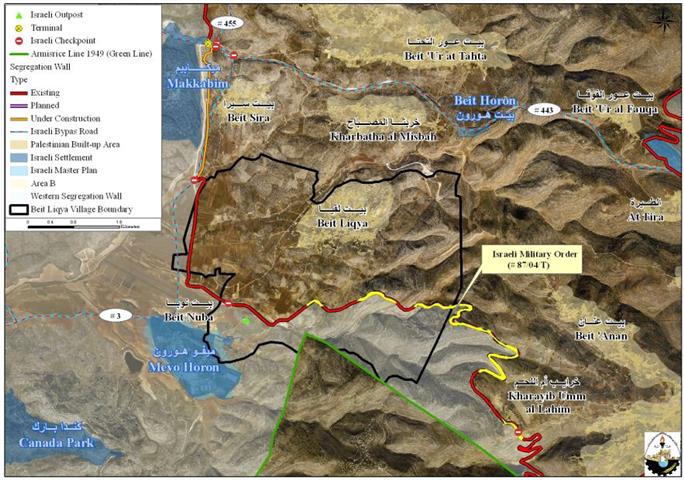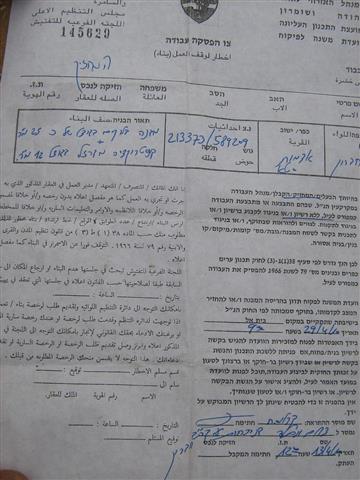General Glance
Beit Liqya is one of the Palestinian towns of Ramallah Governorate, located about 13.4 km away from the city of Ramallah. The town is populated by 10,286 residents where it’s considered as the largest towns of Ramallah Governorate in terms of population (PCBS 2010).
Beit Liqya is bordered by Kharbatha Al- Misbah village from the north, the Segregation Wall from the south, as well as Beit- ‘Anan village from the southeast, At-Tira village from the east, and again by the Segregation Wall from its west.
According to the Oslo II Interim agreement of 1995, Beit Liqya town lands, as well as the rest of the Palestinian Territory were divided into areas A, B and C. In Area A, the Palestinian National Authority has complete autonomy over administrative and security issues, where in area B, the Palestinians have civil responsibilities; while in Area C, Israel has full control over the security and administrative issues. Table 1 clarifies the classification of lands of Beit Liqya:-
|
Table 1: Classification of Beit Liqya’s Land According to Oslo II Interim Agreement oF 1995
|
|
Land Classification
|
Area-km
|
% from the Town Area
|
|
Area A
|
0
|
0
|
|
Area B
|
1,318
|
9.2
|
|
Area C
|
12,935
|
90.8
|
|
Total
|
14,253
|
100
|
Source: Geographical Information System – ARIJ, 2010
The Israeli Colonization Activities in Beit Liqya Town
Beit Liqya has been severely affected by the Israeli colonial plans, mainly by building the illegal Segregation Wall where the town lost more than 1500 dunums from its land for the construction of the Wall.
On March 10, 2010, the Israeli Army handed Beit Liqya municipality a new military order holding number (78/04/T) to confiscate an additional 10 dunums from lands of the town. This order came as an extension to a previously issued military order number 0765/2004, which was issued on March 26, 2004 to confiscate hundreds of dunums of Beit Liqya town lands to construct the Segregation Wall in the area which according to the Israeli maps, will stretch a length of 6 km long along the town’s land. See map 1
Map 1: The path of the Israeli Segregation Wall on Beit Liqya Lands
Mr. Hassan Mafarjeh, mayor of Beit Liqya town indicated that the municipality had filed a petition to the Israeli High Court of Justice in the year 2004, to enable owners of the isolated lands to access and cultivate their lands. The Court granted them the permission, but they have been surprised by the issuing of the new confiscation order, especially since the targeted 10 dunums will not be used to the construction of the Wall.
When the Segregation Wall is completed in Beit Liqya town, 3732 dunums (26% of the town’s total area) will be totally isolated west of the Wall. This means that local residents and owners of these lands will loose their right to reach their own lands without being issued a special permit from the so-called “Israeli Civil Administration” that is controlled by the Israeli Occupation Army.
Furthermore, the Palestinian built-up area of Beit Liqya town is only 703 dunums, which constitutes 4.9% from the town’s total land area (14,253 dunums). 1176 dunums of this area belongs to the master plan of the town, where the municipality of Beit Liqya has submitted many times to the Israeli Civil Administration for an expansion of the town’s master plan, but their request had been repeatedly rejected.
It is worth mentioning that the Segregation Wall in Ramallah Governorate extends along 78.7 km piercing through 23 Palestinians towns and towns isolating others, as in the case of Beit Nuba and some parts of Al-Judeira behind its path, while end up encompassing 14 illegal Israeli settlements and isolating 99069 dunums of Palestinian land behind its path.
To Conclude
Israel insists on violating nternational law, rules and conventions concerning the confiscation of Palestinian land and building the Apartheid Segregation Wall.
-
Article 53 & 147 of the Fourth Geneva Convention indicates that: ‘any destruction by the Occupying power of real or personal property belonging individually or collectively to private persons, or to the State, or other public authorities or social or cooperative organizations is prohibited, except where such destruction is rendered absolutely necessary by military operations.’
-
Art. 23 of the Hague Convention of 1907 also provides: In addition to the prohibitions provided by special Conventions, it is especially forbidden to destroy or seize the enemy’s property, unless such destruction or seizure be imperatively demanded by the necessities of war;
-
Under the Universal Declaration of Human Rights adopted and proclaimed by General Assembly resolution 217 A (III) of December 10, 1948, Article 17 reads: ‘No one shall be arbitrarily deprived of his property.’ Meaning, this bans Israel from destroying or confiscating the property of the Palestinians in any case.
Prepared by:















